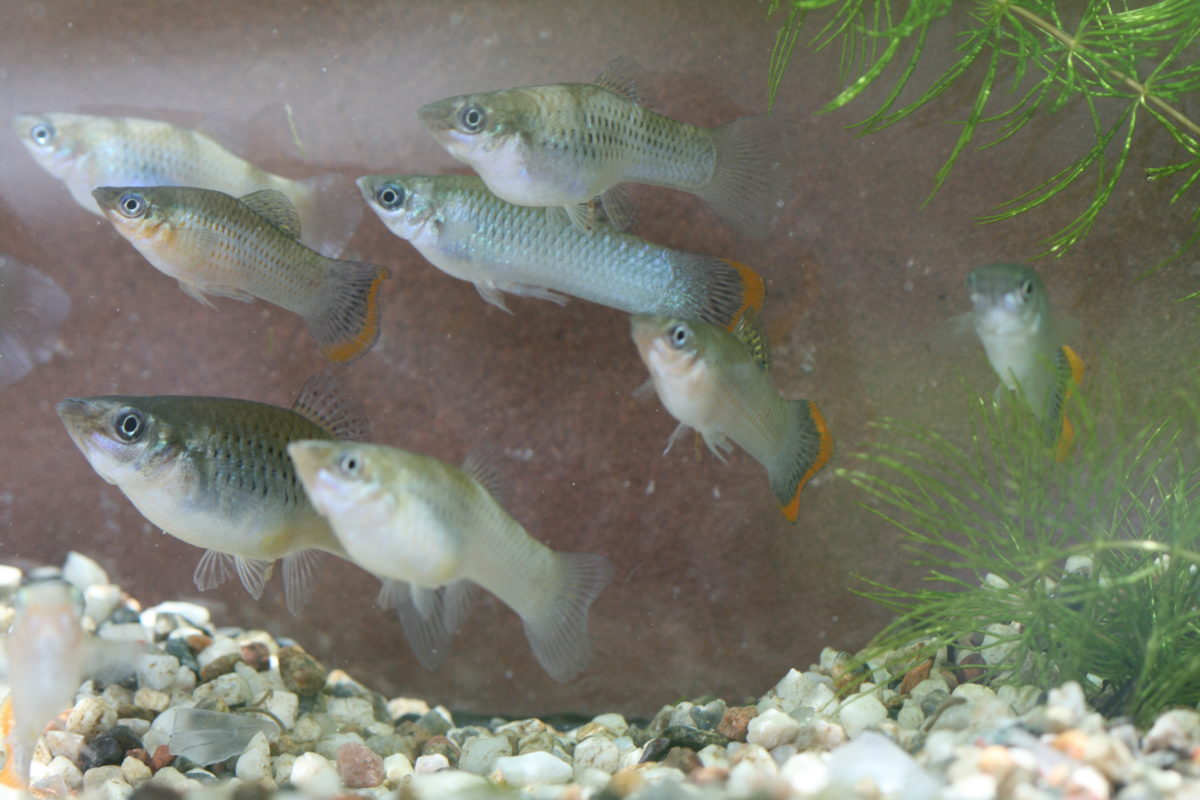We recently processed our Poecilia mexicana, Campeche. We got this wild molly species in June 2009 from Dr. Ptacek of Clemson University. The “Campeche” notation indicates that Dr. Ptacek collected the fish in Campeche, Mexico. It has proven to be one of our most popular short finned mollies. The photo shows both sexes. The males have the orange caudal borders. This species took the prize of Best Non-Goodied Livebearer at the American Livebearers Association‘s 2013 convention.
As is typical with our livebearers we maintain this species in a three 55-gallon vat rotation. One vat houses our breeding colony, another adult fish for sale, and the third for fry and juveniles. To process the fish we first net the fish out of the fry and juvenile and sale vats. Since we process our livebearers every three months (when on schedule), the erstwhile fry and juveniles are usually adults. We sort and inventory the fish. Any remaining juveniles are temporarily set aside. The vats are cleaned by netting out any mulm on the bottom with 10″ brine shrimp nets (by the way, the mulm is usually loaded with Paramecium, a great livefood). The adult sized fish are counted and placed in the vat that had housed the fry and juveniles. Any malformed fish or atypical fish are culled. When working with wild-type fish such as this species, we cull any fish deviating from the appearance, size, and color of the original wild fish. If any really, really interesting mutants are found, they are separated out into one of our experimental tanks and are removed from the population’s gene pool. We temporarily set aside the best specimens among the adults as potential breeders.
We next net out all the adult breeders from the breeding colony vat. Any juveniles that had been set aside are added to this vat, which is not cleaned since fry are fairly sensitive and don’t take rough handling. Remaining in the vat are the current fry and juveniles plus the added juveniles. The breeders are inventoried. Any losses are made up from the potential breeders we’d set aside earlier. Any unneeded potential breeders are put in the sale vat with the other adults. A typical breeding colony of livebearers will have six males and 40-60 females. I like to use six males since with any fewer the subordinate males get picked on too much. With six males aggression is spread around. In fact, I’ve found that the dominant male tends to attack the higher ranking male whenever two males get into a dispute, giving the subordinate male respite. With any more than six males the females are harassed too much.
The vat that had housed the for sale adults, now clean, is set up for the breeding colony. This consists of placing a “cichlid hotel” on the bottom of the vat and on top of it a “fry cage.” A cichlid hotel is made by cutting foot long piece of 2″ PVC pipe and attaching six foot long 2″ in diameter 1/4″aquaculture mesh cylinders to the pipe. A fry cage consists of a cylinder about a foot in diameter and about three feet tall made of the same 1/4″ mesh. A bottom of 1/4″ mesh closes the bottom. (If there is any interest in these two devices, I’ll blog about them later.) The fry cage provides refuge for fry and the cichlid hotel provides hiding places for adults. Also, sometimes we place a pair of breeder Ancistrus cirrhosus in a vat and the cichlid hotel provides a place for them to spawn. We usually add a large sprig of a floating plant, hornwort (Ceratophyllum demersum), providing additional cover for fry and females.
For the next three months we fill orders from the adult and juvenile vats. The breeders proceed to produce the next generation of fry and the three month cycle begins anew.


Robert says
Very interesting post.
I would like to here more about the “cichlid hotel” and the fry cage.
What do you use for vats?
charles says
Robert,
We use 300 gallon vats from Rubbermaid. 40 gallon vats from Tuff Vats. And food grade 55 gallon white plastic barrels.
I’ll do a future post on cichlid hotels and fry cages and how to make them.
Tim Hudak says
Where can I purchase these mollies and how much are they? Thanx
charles says
Tim,
We offer this fish. Here is the link to the page where you can order them: .
Charles